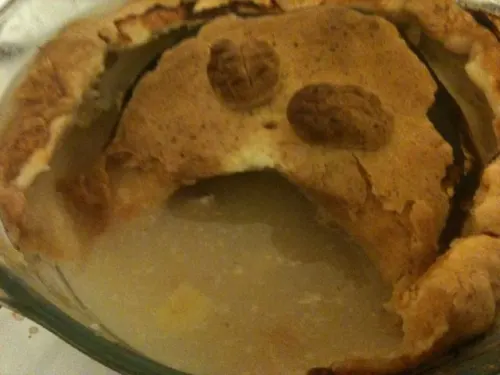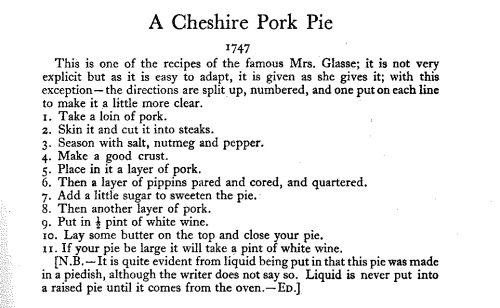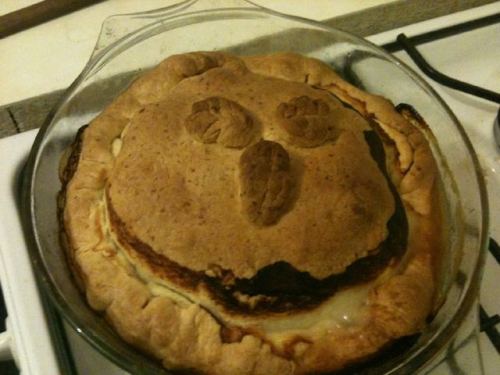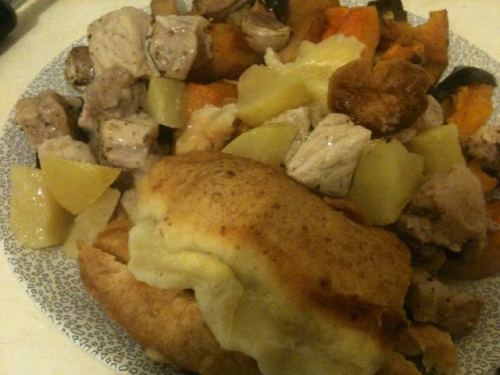This recipe is actually one of the very first vintage recipes I attempted, before even this blog existed. It’s from Florence White’s Good Things in England, which has been featured here many times before, and is probably one of my favourite books – not only did it spark my interest in vintage cookery but it also introduced me to the wonderful Persephone Books, who’ve republished it. Briefly, because I’m sure I’m repeating myself, Good Things in England was White’s attempt in the late 1920s to record traditional English recipes that she felt were in danger of being lost – the resulting book is a glorious compendium of regional and ancient recipes, and is a pleasure to read regardless of whether you plan to cook from it.
So last night I decided to knock up this pie. White notes that the recipe is one of the ‘famous Mrs Glasse’, this being Hannah Glasse and her 1747 book The Art of Cookery. I’ll let Wikipedia do the work here rather than try to summarise the entry. Notably though, it does state ‘Several facsimile editions are still in print, though primarily as a historical work rather than a modern cooking reference‘ (so basically, it’s ideal fodder for this blog).
White is right – this is not an explicit recipe. I made a number of concessions to the 21st Century and to the gaps, namely –
- I had no need to skin the pork, but I did remove the fat from the loin steaks I’d got at the supermarket.
- I cubed the pork. Steaks just seemed weird. Should I have cooked with the whole steak of pork? Would that have worked? Is this meant to be more of a Beef Wellington type dish?
- I did not make a good crust. Jus-Rol kindly made a good crust. I opted for shortcrust.
- I forgot to peel the apples. That’s what paring is, right?
- I put in half a bottle of Chilean Sémillon Chardonnay. I’d had a gin-in-a-can on the bus home from the supermarket on an empty stomach and was unexpectedly more drunk than I should have been. My measures were a little wonky. For the same reason the rolling out of the pastry was half-hearted, to say the least.
- In my drunken fug I forgot to put butter on top. I did attempt to make little pastry leaves though.
As you may have noticed the recipe has no instructions as to cooking time or temperature (thanks that’s great Hannah). I’d say it was in for about an hour, and for the most part at Gas Mark 5, but down to 3 for the last 15 minutes as it was going a bit brown on top. I can’t really remember how long it was in for, as I was working my way through the leftover wine and listening loudly to house music.
When it came out it looked like a funny face:
And then when I’d broken into the crust it looked like an outraged face: Sorry pie!
Sorry pie!
The time I cooked this before I seem to remember the pork as being a bit on the tough side and I was worried the same would happen here, as it has the potential to essentially be meat boiled in wine, but it was actually quite tender and tasty. The wine was excessive and just a bit weird though – I don’t know whether I’d confused the quantities somehow and there should have been more meat/ apple or less wine – it wasn’t even like a gravy that could be served with the pie, just hot, cloudy wine. The apples were a little tart – I should have added more sugar. In terms of spice I could have grated more nutmeg into this and it would have improved it.
Summary – this has the makings of a good pie, but is let down by being a bit too simple and also runny. Here it is with some roasted squash and aubergine:
By Alix




The recipe states a loin of pork: a whole one is a big hunk of meat, even skinned and boned it could weigh a couple of kilos. Hence the amount of liquid suggested. One way easily to thicken the juices is to sprinkle a little flour on each layer of meat [in total a level tablespoon per 500g meat, approx].
Pingback: Tweets that mention A Cheshire Pork Pie | The Vintage Cookbook Trials -- Topsy.com
Love the 18th century adventure – and your blog in general. Not sure how much this is going around across the pond, but…over here we’ve been passing around Stylish Blogger Awards to say thanks for sharing! Check it out: http://www.cookbookarchaeology.com/?p=570
Gin in a can, you say? 😉
It’s a few years too late, but I thought I’d mention that in 1747 a “half-pint of wine” would 8 fluid ounces, not 10. If you were using Imperial measures that might help explain the amount of liquid.